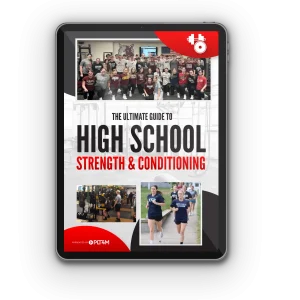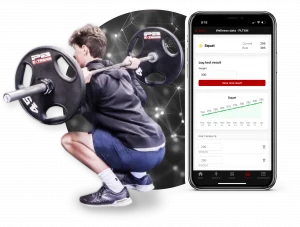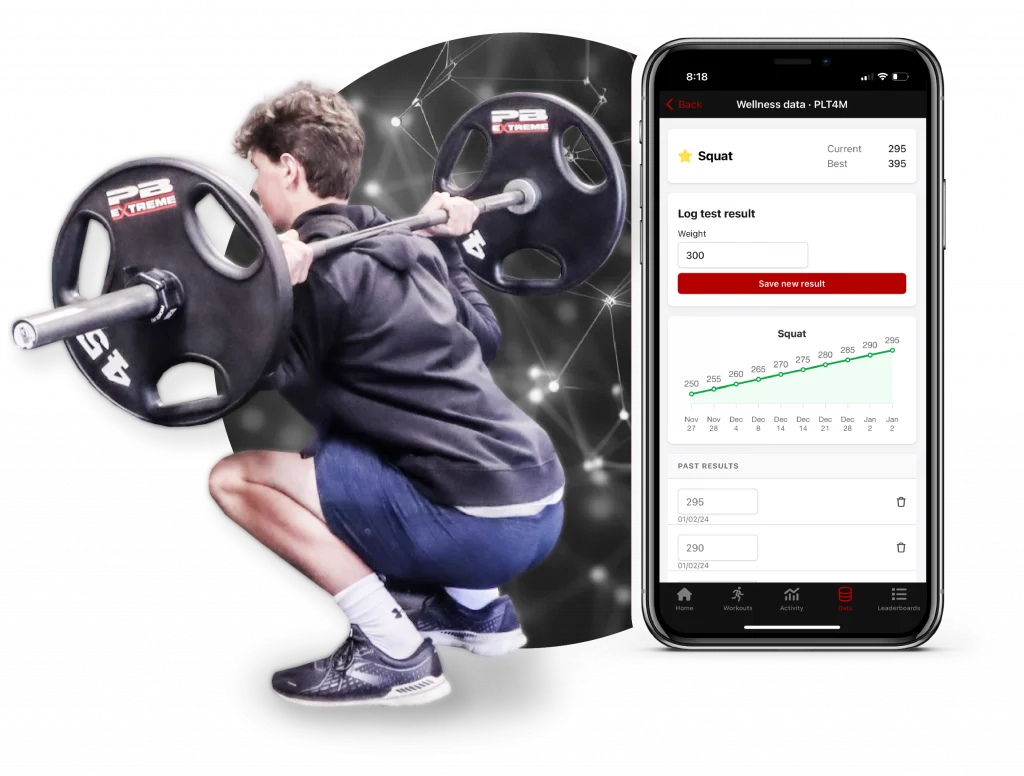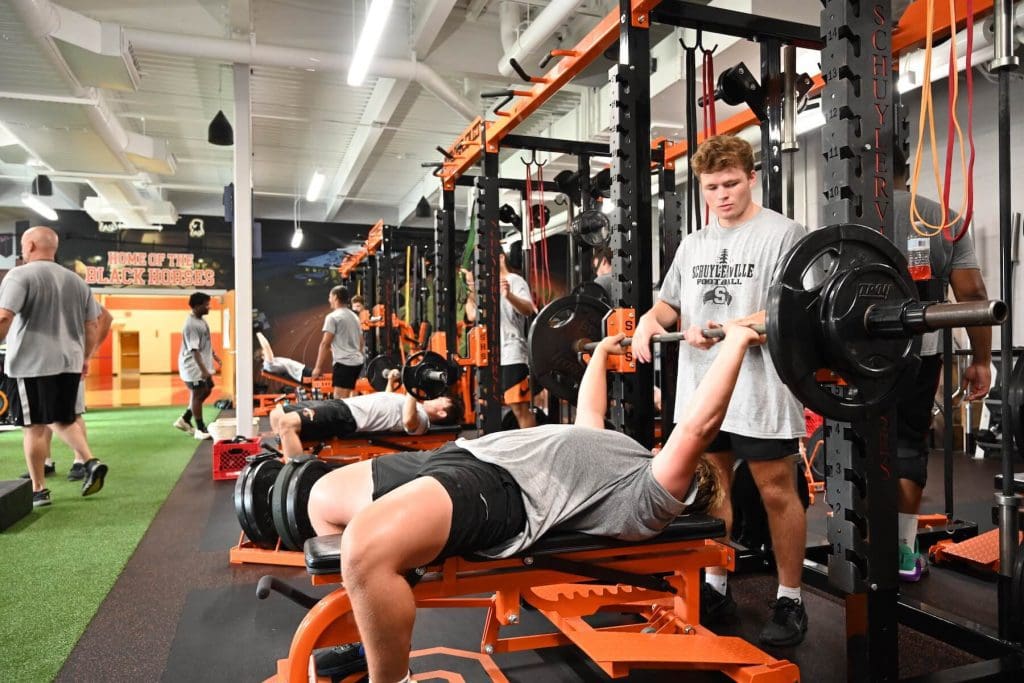Football players at every level know that off-season strength training is the key to in-season success. For high school football programs all the way up to pro teams in the NFL, success starts in the weight room.
But unlike college and NFL teams, high school football teams don’t have access to an army of strength coaches and specialists with state-of-the-art facilities. Instead, high school football coaches have to find ways to develop football offseason workouts on their own.
To help high school coaches, we have outlined below a winning high school football offseason workout program.
This program takes into consideration all of the different elements that make high school football training unique. And in doing so, helps to maximize the time and energy of your team so that come fall, you are ready for Friday nights!
Does your school really need offseason workouts for football?
The simple answer is yes! Your team will benefit from taking part in offseason training for football. An effective off-season football workout regime can help to build strength, power, control, capacity, and promote injury prevention.
And while the benefits of training are simple, the logistics for high school teams are usually far more complicated.
Many of your football players also likely play on different sports teams at the school. For this group, they may actually require in season training throughout the year as well. Other athletes might be new to the weight room and need an on-boarding training program to get them started.
So while your team will benefit from workouts, what they really need is a comprehensive plan that can support athletes throughout the year.

What weights / equipment is needed to run a high school football offseason workout program?
High school offseason football workout programs don’t need to reinvent the wheel! Whether training sessions are in the weight room or on the field, having the basics can go a long way.
Must Have Equipment
Barbells, Bumper Plates, & Rack
Dumbbells and Benches
Pull-Up Bar/TRX/Rings
“Run” Option
PVC Pipe
Nice To Have Equipment:
- Kettlebells
- Jump Rope
- Plyometric Boxes
- Foam Roller/Lax Ball
- Cardio Machines
- Bands
Free Download!
The Ultimate Guide to High School S&C
Learn how to navigate the many logistical challenges that face high school coaches, and get insights into how to program effective workouts.

12 week offseason football workout program
The goal of an off-season is to take a complete look at what it takes to be great during the in-season. We are talking about complete strength, power, speed, control, capacity, durability, and more.
And so that we maximize all of the parts together, it is important we consider starting light, low, and slow with an overall progression of building to heavy, fast and high. Rome was not built in a day, and neither are gains in the off-season. Consistency is key!
In this off-season preview, you will get a taste of what one week can look like with two days in the weight room and two days focusing on speed and agility.
Weight Room Workouts Format
Over the course of the program, we place an emphasis on building raw total-body strength through unique phases of the powerlifts and their variations. Simultaneously, we will develop our rate of force production, or “Power”, through different plyometrics, ballistics, and a full progression of the “Clean” movement – utilizing all of it’s variations from the top down. Lastly, we will consistently build durability and work capacity through a blend of hypertrophy training, accessory strength work, and Metabolic conditioning.
Each weight training day contains a brief warm up (with dynamic movement, mobility, and technique work), pre-hab & activation (injury prevention, core, etc), power development (plyo, ballistics, and/or OLY lifts), max strength (powerlifts), accessory strength work (unilateral work, push/pull, etc), and a short “finisher” for capacity and volume, complete with full instruction & explanation.
Speed Workouts Format
This portion is aimed at developing an athlete’s speed and change of direction ability.
Over the course of 24 total sessions, two major training cycles will be employed, with pre-, mid-, and post-assessment of all the relevant performance markers listed below.
In each 12-session cycle, a major emphasis will be placed on building pure speed through the combination of acceleration work, max velocity training, and true sprinting. Simultaneously, we will hone our running mechanics for maximally efficient movement, grow our stride rate of force production, or “Power” , and develop our ability to break through deceleration/force absorption.
Lastly, we will put it all together through intentional, closed-chain change of direction drills designed to improve coordination and movement economy through athletic patterns.
Lift 1: Bench & Deadlift
These first few sessions are JUST ABOUT GETTING BACK INTO the true strength game.Train SMART, and then hard. This week, err on the side of “easing in” rather than jumping into heavy weights.
You may feel that the weight is on the lighter side for your core lifts – that is intentional! Focus on form and movement, and we will add weight as we go!
Warm Up
Walking Lunge
Single Leg RDLs
Hurdle Walks
Side Lunge
Quad and Reach
Toe/Heel Walk
Circles Forward/Back (switch Halfway)
High Knees
Butt Kicks
75% Sprint x 2
85% Sprint x 2
Plyometrics - Snap Down To Lateral Jump
10 Total Reps (5 Each Side)
Single Efforts, Rest and Reset Between Reps
We are looking for a smooth combo of POWER and CONTROL. Hit your positions in the snap down, but then explode with speed up and out to the side on your jump. Do NOT FORGET to focus on the second landing as well!
Strict Pull Up Assessment
Reps Note
8 Easy Pulls
5 Moderate Pulls
2 Hard Pulls
Max reps Strict Pulls – Record Result
Elbow Plank Assessment
Max Plank Hold
Here’s the deal – this is a STRICT test. You fail the moment you deviate from our points of performance. It’s not how long you can stay off of the ground, it is how long you can HOLD A PERFECT PLANK without moving.
Bench Press/Scap Superset
Rest well between sets
5a) Bench Press
Reps Weight
8 50% * Bench
8 55% * Bench
8 60% * Bench
8 63% * Bench
8 66% * Deadlift
5b) Band Face Pulls
Reps Weight
8 Slow/Controlled
8 Slow/Controlled
8 Slow/Controlled
Deadlift/Bridge Supertset
6a) Deadlift
Reps Weight
5 55% * Deadlift
5 55% * Deadlift
5 56% * Deadlift
5 56% * Deadlift
5 57% * Deadlift
Reps Weight
5ea Slow/Controlled
5ea Slow/Controlled
5ea Slow/Controlled
6a) Deadlift
Reps Weight
5 55% * Deadlift
5 55% * Deadlift
5 56% * Deadlift
5 56% * Deadlift
5 57% * Deadlift
Reps Weight
5ea Slow/Controlled
5ea Slow/Controlled
5ea Slow/Controlled
Pull/Press/Split-Squat Superset
Move slowly but steadily throughout the 3 movements. Rest for about 1:00 between rounds. Looking for roughly 10 moderately challenging single reps per set, with some wiggle room above or below depending on difficulty. This is NOT about grabbing a heavy weight and swinging it around. Challenge yourself to get great, controlled reps
Reps Weight
8-12ea 20%*Bench
8-12ea 20%*Bench
8-12ea 20%*Bench
Reps Weight
6-8 Each 14% * Bench
6-8 Each 14% * Bench
6-8 Each 14% * Bench
7c) DB Split Squat
Reps Weight
8-10 Each 16% * Squat
8-10 Each 16% * Squat
8-10 Each 16% * Squat
Jump Rope Assessment
Max single under reps in 1:00 minute
Record your time:
Air Squat Challenge - 1 Minute
Perform Max Reps for 1 min
Record your time:
Speed Session # 1
Alright everyone, it’s time to kick off our speed training!
Every athlete wants to get faster. BUT, very few approach the pursuit of speed with the right knowledge or mindset. Speed work is NOT CONDITIONING. You should think of it more like weightlifting. We are operating at intensities close to or at our maxmimal ability, like lifting a heavy % in the back squat. That means a few things:
- Form, technique, and control are hugely important. You can only maximize your output if you move with INTENT.
- It does not take many reps to yield gains
- Each rep MUST be done while relative FRESH. Just like lifting, we need appropriate rest times. You can only operate at 100% if you are fully recovered from the previous set or rep. Being tired, or fatigued, is NOT THE GOAL!
As with everything else, we are best served by reading all instructions, paying attention closely to coaching points and position/technique, and working with total intent. Make the most of your reps.
Speaking of, we are also testing speed and change of direction today!
But, here is the deal – we absolutely must understand the point of testing, and how to do so appropriately. This is only meant to give us a loose gauge for where we are at, it’s no be-all, end-all during which we need to chase numbers. This time around, especially, since we have NOT been actively training speed. We need to ease into it. Our assessments are “SOFT,” meaning they are not tests that we can pass or fail, they are just an opportunity to get a baseline set of data. Don’t overreach and risk strains or muscle tweaks. Approach each element EXACTLY as intended.
Remember, outside of running track, a sprint time is just a simple data point, and holds very little true “value” on it’s own. It’s a piece of the larger puzzle, so let’s not get over-obsessed with our times in one direction or another.
Ok, plenty to get done today, so let’s go!
Speed Prep Dynamic Warm Up
Perform each of the following for 10 yards:
A-Skip Forward
A-Skip Backward
Froggy Forward
Froggy Backward
Skip & Clap
Power Skips
Ankling
Runner’s Butt Kicks
Side Slides
Karaoke + Knee Punch
Technique Work: Arm Swings & Marching Steps
3 Rounds of:
:15 Seated Arm Swings (Easy, Medium, Hard)
10 Yard Marching Steps
:30 Rest
For arm swings, let’s begin nice and easy with smooth, slow reps for 15 seconds. Focus on a relaxed hand, a relatively stationary elbow, and a smooth swing about the shoulder. In each of the next two rounds, increase your speed and intensity a bit, but only so long as you can maintain control.
10 Slow, Controlled Yards per round
Now we shift our focus to everything below the hips. The goal, here, is to solidify proper knee drive and FOOT STRIKE. Your foot should make contact with the ground below your hips, and should hit the mid-to-forefoot, with the hell just kissing the ground.
This is about mechanics – don’t rush! Do it right and you will tech more body how to run faster by being more efficient.
Acceleration Work: Sprints: Standing Start
Warm Up:
2x10yd Starts @ 75%
Rest as needed between reps
Working Reps:
2x10yd Starts @ 85%
1x20yd Start @85%
Rest for a full 1:00 between reps
OK – our focus here is on ACCELERATION. That means attention must be paid to our intensity, effort, and control. This is NOT conditioning in any way. We want to dial in that “0-to-60” ability in our running.
So, we set up well at the line, explode out with dynamic control (knee drive, torso lean, foot strike, etc), pushing hard through the 10yd mark, then coasting SLOWLY to come to a stop.
The key is in making the MOST OF EVERY REP, however “small” it may seem.
Acceleration Assessment: 20 Yard Dash
20 Yard Dash Assessment
3 Attempts
We will now SOFTLY assess our “acceleration” ability by recording a 20yd Dash time. Please understand, this is only to serve as a baseline for future comparison. We do NOT need to sell out in hopes of an impressive time. Rather, we want to move well, avoid any strains or tweaks, and simply find a jumping off point for our training data.
Here’s the deal – you get 3 Attempts (and 3 only!). All 3 sprints should be timed by a partner with a stopwatch/cell-phone…or by your coach with whatever technology you may have at your disposal.
Timer stands at the 20 Yard Mark.
Timer presses start ON THE FIRST MOVEMENT OF SPRINTER
Timer presses stop AS RUNNER CROSSES 20 YARD LINE.
Record, write down, or screenshot the time of each attempt. After all 3 sprints – you will LOG YOUR MIDDLE TIME. Not the fastest, not the slowest, but the MIDDLE.
*Please understand, hand-timed sprints are always “unofficial” compared to laser-timed reps, and are often “faster.”
Max Velocity Work
4x10yd Flys, 85% Speed
Minimum 1:00 Rest Beween Reps
Now we work another side of the speed game – your TOP SPEED, or “Maximum Velocity.”
We do this by using a lead-in distance to build up speed before carrying that top speed for a given distance, this time just 10 yards, hence the “Flying 10” name.
Start 10 yards from your define sprint window, build up speed and hit your target velocity (just 85% today) for the entire 10 yards before coasting to cool down slowly.
Think of that 10 yard window as an opportunity to be moving at your best, top speed run of the day. Powerful arm action, knee drive, foot strike and torso lean. Really dial in that sprint shape!
Quickness Change of Direction Assessment : Pro Agility
Warm Up:
2 Reps, 1 Right, 1 Left
Rest as needed
Assessment:
3 Attempts
Minimum 1:00 Rest Between Reps
To wrap up our day, we will hit another soft assessment – this time in a drill that represents quickness and change of direction skill/efficiency.
The key here is not selling out in “speed” or exertion, but rather, focusing on your efficiency of movement. Watch the video to best understand the approach, then give it a shot!
Again, we will be entering the MIDDLE time of our 3 attempts below.
Remember, this only serves as a baseline to compare back to down the road!
Lift 2: Squat & Clean
Same basic deal as the first lift. We are focused on assessment of some accessory training domains, while getting back into the pure strength and power game.
Today, we have some high-velocity power work, followed by 1 major strength movement (the squat), then some DB accessory strength work. Be sure to read every note, understand your INTENT, and execute your lifts with attention to detail. Make the most of every rep.
Let’s go!!
Dynamic Warm Up: Hips
1 Minute of Light cardio, then:
1. Traveling Spiderman
2. Hurdle Walk Forward
3. Hurdle Walk Backward
4. Crab Walks (Each Side)
5. Duck Walk
Snap Down To Vertical Jump
6 Single Effort Reps, Increasing in Intensity
Rest and Reset Between Reps
Use the snap downs to dial in efficient (and safe!) jumping mechanics. Start super easy, and increase your intensity over the 6 reps.
Push Up Assessment
Warm up and then perform Max Reps in 1 Minute
Record your results:
High Hang Power Clean
Rest a good 2 minutes between sets. Weight should be relatively LIGHT, but your effort should be INTENSE. We want to move that bar with explosiveness. Really focus on driving the movement with your hips, not your arms.
Reps Weight
3 50% * Clean
3 60% * Clean
3 65% * Clean
3 65% * Clean
3 65% * Clean
Squat/Plank Superset
Same strength approach with our Squats today – we are intentionally keeping the loading LIGHT. We want absolutely FLAWLESS – and COMPLETE DEPTH/ROM movement.
5a) Back Squat
Reps Weight
5 50% * Squat
5 55% * Squat
5 60% * Squat
5 65% * Squat
5 70% * Squat
Reps Weight
1ea :10 Sec Hold
1ea :10 Sec Hold
1ea :10 Sec Hold
Push/Pull/Lunge Superset
Reps Weight
8-10 Each20% * Bench
8-10 Each20% * Bench
8-10 Each20% * Bench
Reps Weight
8-10 Slow, Strict Pulls
8-10 Slow, Strict Pulls
8-10 Slow, Strict Pulls
6c) DB Back Lunges
Reps Weight
8-10 18% * Squat
8-10 18% * Squat
8-10 18% * Squat
Recovery
If time allows, get some proactive recovery done through a small cool-down session.
Couple minutes of super easy cardio (bike/elliptical is great), then some static stretching or foam rolling. Trust me when I say taking 5 minutes to get this done will add up over time much to your benefit.
Speed Session # 2
Just as with our previous session, we are just getting rolling with our true speed training.
Let’s ease in properly.
Use this session to focus on movement mechanics, the intent of our drills, and the maximization of our output on each rep. We will also be softly assessing a couple more performance metrics. Remember, it’s really NOT about achieving a great score, today. It is just about establishing some data for future comparison, while staying healthy and taking the first steps towards improved speed and change of direction ability.
Do it all the “right” way!
Warm Up
:30 Light Jog/Cardio
Then, 10 yards walking each of:
Walking Lunge
Single Leg RDLs
Hurdle Walks (forward & backward, switch halfway)
Side Lunge
Quad & Reach
Toe/Heel Walk Shoulder Circles Forward & Back (switch halfway)
High Knees
Butt Kicks
75% Sprint x 2
85% Sprint x 2
Power Work: Wall Lean High Knee Drives
12 Singles (6 Each Leg, Alternating)
Rest & Reset Between Reps
We are working explosive power CREATION, here. You should think of these more like a plyometric (jumping reps) than any sort of conditioning.
Today we hit “single reps” – this means we set up against the wall (or whatever surface is available, like a fence) with good torso lean and strong core engagement/neutral spine.
We bring one leg up to that high knee “drive” position. We then SNAP that drive leg down, striking the ground right next to the off leg, hitting with the mid-to-forefoot. At the same time, the off leg snaps UP to that high knee position. We are effectively just switching leg positions with as much speed and control as possible.
Take the time to make each rep AWESOME. Rest and reset as needed.
DON’T RUSH!
Deceleration Work
4 Rounds of:
4 Lean Fall Lunges (2 Each)
4 Shuffle-Stop (2 Each Direction)
:40 Rest
Working our ability to “break” – aka decelerate. We’ll start super simply. These drills should be about your control and body position, not speed or intensity. For our LFLs, focus on slowing your fall by dropping into a good lunge position, torso and front shin inclined in the direction of the fall. Absorb your momentum with that front leg like a shock absorber on a car or bike. Hold for a second at the bottom before resetting for the next rep.
4 Shuffle-Stops Per Round, 2 each side
(5 Yard Shuffle and stop on each rep)
This may seem simple, but lateral movement, and lateral breaking is harder that it seems. Let’s start super slow and work our positioning. Our focus should be on that absorption of lateral momentum on the lead leg and re-establishment of a neutral center of gravity…think about almost rocking smoothly back to a good athletic position upon stopping.
Speed Work: Sprints - Standing Start
Warm Up:
1x10yd @ 75%
1x20yd @ 75%
Rest as Needed
Working Reps:
1×10 @ 85% (Rest :20)
1×20 @ 85% (Rest :40)
1×30 @ 85% (Rest 1:00)
1×40 @ 85%
OK – our focus here is on ACCELERATION into TOP SPEED. That means attention must be paid to our intensity, effort, and control. The goal is to achieve your top speed on any given rep, for AS MUCH OF THE DISTANCE AS POSSIBLE. This is NOT conditioning in any way. Rest appropriately.
So, we set up well at the line, explode out with dynamic control (knee drive, torso lean, foot strike, etc), pushing to top speed as quickly as we can, holding that through the given distance, then coasting SLOWLY to come to a stop.
The key is in making the MOST OF EVERY REP, however “small” it may seem.
Speed Assessment: 40 Yard Dash
40 Yard Dash Assessment
3 Attempts
We will now SOFTLY assess our “top speed” ability by recording a 40yd Dash time. Please understand, this is only to serve as a baseline for future comparison. We do NOT need to sell out in hopes of an impressive time. Rather, we want to move well, avoid any strains or tweaks, and simply find a jumping off point for our training data.
Here’s the deal – you get 3 Attempts (and 3 only!). All 3 sprints should be timed by a partner with a stopwatch/cell-phone…or by your coach with whatever technology you may have at your disposal.
Timer stands at the 40 Yard Mark.
Timer presses start ON THE FIRST MOVEMENT OF SPRINTER
Timer presses stop AS RUNNER CROSSES 40 YARD LINE.
Record, write down, or screenshot the time of each attempt. After all 3 sprints – you will LOG YOUR MIDDLE TIME. Not the fastest, not the slowest, but the MIDDLE.
*Please understand, hand-timed sprints are always “unofficial” compared to laser-timed reps, and are often “faster.”
Change of Direction Assessment: T-Drill
Warm Up:
2 Reps, 1 Right, 1 Left
Rest as needed
Assessment:
3 Attempts (Athlete Choice on First Turn Direction)
Minimum 1:00 Rest Between Reps
To wrap up our day, we will hit another soft assessment – this time in a drill that represents our change of direction ability in “non-linear” running (curved line running).
The key here is not selling out in “speed” or exertion, but rather, focusing on your efficiency of movement. Watch the video to best understand the approach, then give it a shot!
Again, we will be entering the MIDDLE time of our 3 attempts below.
Remember, this only serves as a baseline to compare back to down the road!

Ready To Raise The Bar?
Our platform is the #1 choice for coaches and teachers looking to take their program to the next level. Learn how you can save time, improve results, and increase student engagement.
Key takeaways on our offseason football training program
The off-season doesn’t have to be complicated. No single training session will be the reason a team wins or loses. When you simplify things down, high school football players will see results when taking a well-balanced and consistent approach.
And yes, your athletes might be excited about one rep maxes and max height box jumps, but help them to see that doing the basics well, will lead to the best results come fall. It takes doing all of the little things consistently to develop a complete athlete.
A successful off-season is one that athletes can progress overtime so that come fall, they are ready for the challenges that a grueling football season will bring.
Technology’s Role In High School Off Season Workout Program’s
Many high school off season workout programs are still cluttered with old pen and paper tracking. Technology can play an integral role in maximizing your off-season!
With PLT4M, teams and schools can go digital with training. Every PLT4M workout is loaded into the PLT4M app where student-athletes can access personalized workouts and individualized weights. Check out how Schuylerville High School in New York attacks the off-season with PLT4M.
Unlock The Full 12-Week Training Program
For sample workout lessons, download the PDF. However, putting together a full high school football offseason workout program requires not only a plan, but a means of executing it.

A few example workouts are great, but you need more than just a sample football offseason workout program pdf.
With PLT4M, you have the opportunity to take your football offseason workouts to another level. Through PLT4M’s digital tool you can personalize athletes workouts, track and monitor progress, and adapt week to week based on the unique needs of your team and program!
Schedule a free consultation with a coach on our staff to map out your off-season. In thirty-minutes you can have your plan organized and athletes ready to go! Let’s tackle the off-season together.







